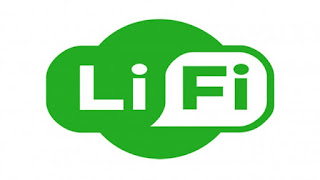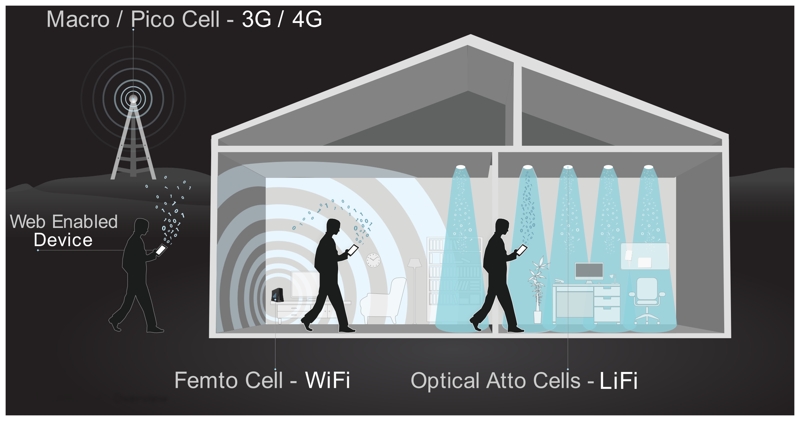TAG | wifi lighting
| In France’s Carrefour supermarket, visible light communication is used to transmit information to visitor’s smartphones. |
The development is the latest leap forward in the up-hill gallop that is the progression of Li-Fi, and is a move that will no-doubt raise the profile of the new technology, by rolling it out onto a bigger stage.
The first live demonstration of Li-Fi in front of an audience was given just a few weeks ago at LuxLive in London.
Recently though, the technology’s forward momentum seems to have slowed down a little, with limited pilot implementations and demos from vendors such as Scotland’s pureLi-Fi and others, being the only evidence of implementation of the technology in the field.
The news from Philips is likely to reverse this trend and the company looks set to invest in the technology in a push toward commercialising it.
The lighting giant is planning to leap into the new and, potentially, lucrative Li-Fi market, by purchasing Luciom, a small French company, which specialises in visible light communication (VLC).
‘Philips Lighting acquired Luciom at the end of 2016,’ a Philips spokesperson confirmed to Lux’s sister publication, LEDs Magazine, noting that all eight of Luciom’s employees now work for Philips.
Luciom is developing several technologies related to VLC, including Li-Fi. Philips appears to be particularly interested in Luciom’s potential to improve Li-Fi in several ways, including speed, coding, decoding and reliability.
Once Li-Fi spreads as a technology, it is hoped that it can become another means of wireless internet transmission, assisting and complementing Wi-Fi, by opening much more frequency to internet use.
Wi-Fi with its radio frequencies is more limited than the considerably wider spectrum of LED lightwaves on which Li-Fi data rides.
Luciom is best known for a ‘tagging’ scheme, which individual LED lights use to uniquely identify themselves in one-way indoor-positioning systems. Compared to two-way Li-Fi, indoor-positioning is a more basic form of VLC that sends small amounts of information from a light to a phone or other gadget.
A number of retailers are experimenting with one-way VLC to try to engage shoppers in stores with information and direct them to promotions. Philips has had a trial with a Carrefour store in France and with the Dubai-based retail chain aswaaq. In the US, Target is trialing the technology, although it has never revealed its supplier, as Lux Review reported last year.
Philips is believed to have acquired Luciom for less than €10 million. LEDs Magazine understands that at one point Philips might have raised patent infringement queries related to Luciom, which could have factored into the price of the purchase.
‘The terms of the acquisition were not disclosed,’ the Philips spokesperson said via email, in response to questions about any patent implications.
bidirection li-fi · lifi · lifi led · light control · luciom · Novel Energy Lighting · philips li-fi · smart buildings · visible light communication · wifi lighting
Lux reports: A tech revolution is happening in lighting – and the speed of development is blistering. Here we identify the biggest trends you need to know about. And a few are rather surprising….
 1 Indoor location tracking
1 Indoor location tracking
The latest tech uses lights in conjunction with smart phones to accurately locate people with 10cm accuracy within an indoor space. Once the building owner knows where you are, they can interact with you to deliver real time marketing messages or offer better services, or perhaps they’ll just track what you do and figure out how to use the data.
Who to watch: Acuity Brands, Philips
 2 Camera-based lighting control
2 Camera-based lighting control
Lighting controls today typically use infrared, ultrasonic or microwave sensors to detect movement, which means they are liable to false triggering or switching prematurely when people aren’t moving. Camera technology is so cheap (you probably have two in your smart phone) that they are now being used in lighting control.
Who to watch: EWO, Zumtobel, Steinel, Hubbell
 3 Self-learning control systems
3 Self-learning control systems
The concept of a device learning its own settings has been pioneered by Google’s acclaimed Nest Labs in its thermostats. The concept lends itself perfectly to lighting controls so that sector is examining how the approach can be adopted to enable the system to self-commission and learn how a space is being used over time.
Who to watch: Helvar
 4 Super capacitors
4 Super capacitors
The Achilles’ heel of emergency lighting is batteries, which degrade over time. However, the improvements in efficiency of LEDs and advancing capacitor technology mean it is possible to get an hour of lighting back-up without batteries. This means that emergency lighting can have a maintenance free life of up to 10 years.
Who to watch: Teknoware, Ledo
 5 Integrated street lights
5 Integrated street lights
Street lights or rather the columns which hold them off the ground used to be a convenient place for dogs to use as toilets, now they’re being crammed full or other technology from CCTV systems, PA speakers, Wifi transmitters and electric car charging points. This reduces street clutter and could provide funding streams for public lighting.
Who to watch: Schreder, Hess, Philips
 6 Inductive power coupling
6 Inductive power coupling
Although this technology has been around for years – it’s used to charge your electric toothbrush – manufacturers are now exploring ways in which it can used for lighting. It’s a perfect way to install an unground uplight and avoid the age old issue of water ingress, or connect a retail lighting display to power without wires.
Who to watch: Auraled, Design LED Products
 7 DC power networks
7 DC power networks
The battle of the currents was settled in favour of AC back in the 1890s, but LEDs and a proliferation of low-power devices mean Round Two has started. Power over Ethernet (PoE) is one embodiment bundled up as part of a computer network, but we’ve also seen DC-powered track lighting, which results in smaller fixtures.
Who to watch: Cisco, Zumtobel
 8 Lights which aren’t just lights
8 Lights which aren’t just lights
With sensors becoming so cheap, and lights getting connected to the Internet, light fixtures are starting to get packed out with sensors not related to lighting, such as ambient temperature and air quality. That data can be shared with other building services or harvested for other big data applications.
Who to watch: Gooee, Sensity Systems, Acuity Brands
 9 Miniaturisation
9 Miniaturisation
Everything in lighting is starting to shrink dramatically. Think chip-scale LED arrays, compact optical systems and ultra thin LED drivers (the smallest we’ve seen is just 13mm high). This should result in ultra-small downlights, in-ground uprights and super-slim linear fixtures, and lower materials costs for the manufacturer.
Who to watch: Lumileds, Samsung, Osram, iGuzzini
 10 Li-Fi
10 Li-Fi
Wi-fi over lighting, or Li-Fi to give it the name coined by inventor Harold Haas, can transmit data 100 times faster than wifi by modulating the light, which would mean you could download the entire set of Star Wars movies in around one second. It works by pulsing the LED light at extremely high frequencies which is undetectable to the human eye.
Who to watch: PureLifi, Toshiba
dc power networks · google nest · indoor location tracking · inductive power coupling · integrated street lights · lifi · lighting trends · Novel Energy Lighting · super capacitors · wifi lighting
8
Megaman Ingenium BLU – How it works
Comments off · Posted by admin in LED, LED Candles, LED downlights, LED GLS, LED GU10, LED Spots
INGENIUM® Smart Lighting gives you full control, via your smart device or remote control, of the on/off, dimming and scene setting of your environment. Its ease of use, installation and scalability makes INGENIUM® perfect for an endless list of applications.
bluetooth lighting · megaman ingenium · Megaman LED · megaman smart lighting · Novel Energy Lighting · wifi lighting
Tech start-up company Velmenni has used Li-Fi-enabled lamps to transmit data at speeds of 1Gbps. Laboratory tests have shown theoretical speeds of up to 224Gbps.
The company tested the method of delivering data, which uses the visible spectrum rather than radio waves, in a working office.
The visible light spectrum is 10,000 times greater than the RF spectrum used in Wi-Fi, and Li-Fi can achieve about 1000 times the data density of Wi-Fi because visible light can be well contained in a tight illumination area, whereas RF tends to spread out and cause interference.
Velmenni tested the technology in an office in Tallinn, Estonia, to allow workers to access the internet and in an industrial space, where it provided a smart lighting solution.
Speaking to the International Business Times, chief executive Deepak Solanki said that the technology could reach consumers “within three to four years”.
The term Li-Fi was coined by Professor Harald Haas, co-founder and chief scientific officer at Edinburgh-based pureLiFi. He demonstrated the technology at a TED (Technology, Entertainment and Design) conference in 2011.
His talk, which has now been watched nearly two million times, showed an LED lamp streaming video. Professor Haas described a future when billions of light bulbs could become wireless hotspots.
One of the big advantages of Li-Fi is the fact that, unlike Wi-Fi, it does not interfere with other radio signals, so could be utilised on aircraft and in other places where interference is an issue.
But the technology also has its drawbacks – most notably the fact that it cannot be deployed outdoors in direct sunlight, because that would interfere with its signal.
Neither can the technology travel through walls so initial use is likely to be limited to places where it can be used to supplement Wi-Fi networks, such as in congested urban areas or places where Wi-Fi is limited, such as hospitals.
pureLiFi, established in 2012 as a spin-off from the University of Edinburgh, where its research has been in development since 2008, demonstrated a commercial Li-Fi network system, Li-Flame, this year at a major mobile technology show in Barcelona. “This is developing very quickly – it’s just a question of maturity,” says Nikola Serafimovski, pureLiFi’s director, product marketing. “My expectation is that this will be a widespread technology in a 24-month timeframe.”
Picture: pureLiFi
For more lighting news visit www.novelenergylighting.com
led lighting · li-fi · lifi · Novel Energy Lighting · wifi lighting · wireless lighting




